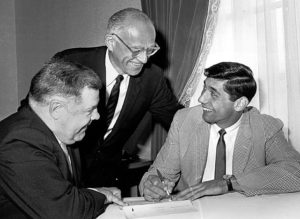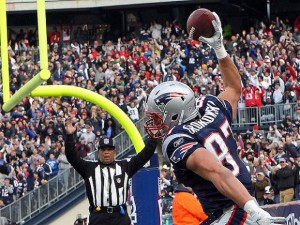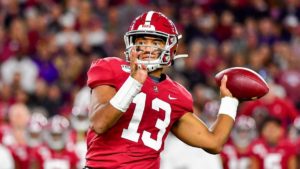The 2020 Draft is now over, which means there are an endless number of places where you can read recaps, draft grades, and who are the winners and losers of the past three days. But there are no answers yet to how the 2020 draft prospects will turn out; on the other hand, we now have 5 years of data to analyze the 2015 Draft. So let’s do that today.
Sports Illustrated’s draft experts Chris Burke & Doug Farrar graded each team’s draft five years ago, and I will be using that recap in this article. Burke and Farrar handed out 4 A grades — including one to Minnesota and one to Jacksonville. With the benefit of hindsight, what do the numbers say? As it turns out, according to my methodology, the Vikings did indeed have the single best draft. Nice job, Chris and Doug! Here’s what Farrar wrote about the Vikings haul:
Minnesota’s primary needs were at cornerback and offensive tackle. It dealt with the first issue at pick No. 11 by taking Michigan State’s Trae Waynes, a highly physical and aggressive press cornerback. He’ll be a perfect bookend for Xavier Rhodes if he learns to deal with crossing routes and avoids a heap of penalty flags. Pitt right tackle T.J. Clemmings dropped to the fourth round due to medical concerns, but if the converted defensive lineman can stay healthy, he might be the best tackle out of this class in a couple years. Second-round linebacker Eric Kendricks should be able to start right away in the middle of Mike Zimmer’s defense, while third-round pass-rusher Danielle Hunter from LSU is both freakishly athletic and raw like sushi. He’ll need some time with a line coach, but there’s a lot to like there. In addition, the Vikings got two much-needed targets for Teddy Bridgewater: Southern Illinois tight end MyCole Pruitt (one of my favorite small-school guys this year) and Maryland speed receiver Stefon Diggs, who can line up all over the place.
Waynes, the team’s first overall pick, was a disappointment: he was inconsistent during his time with the Vikings, and was only a full-time starter for the last 3.5 years. The team did not resign him, and he’s now in Cincinnati. Clemmings didn’t quite turn out as planned, although he did start for 30 games for the team. But for a team that didn’t nail its first pick, the rest of the draft was superlative. Diggs, a 5th round pick, has been the best receiver in the Draft outside of perhaps Amari Cooper, who went 4th overall. Hunter has been one of the steals of draft, recording a 2015 class-high of 54.5 sacks. And Kendricks has turned into one of the best linebackers in the league, earning first-team All-Pro nods in 2019.
On the other hand, Jacksonville’s draft hasn’t quite been so good.
The Jaguars are coming. Maybe not in 2015, maybe not in 2016, but soon. This draft without question kept this franchise’s positive momentum, from a talent standpoint, rolling in the right direction. Jacksonville made one solid decision after another, right through Notre Dame tight end Ben Koyack in round 7.
Opinions varied on this class’s top pass rusher, but Dante Fowler was at or near the top of the list, and Gus Bradley can turn him into a star. Running back T.J. Yeldon and guard A.J. Cann should be starters by Week 1, as well. But the real gems here came in rounds 5 and 6, respectively: Florida State wide receiver Rashad Greene, a sharp route-runner and productive performer; and penetrating three-tech tackle Michael Bennett, a remarkable value at pick No. 180.
The Jaguars caught some bad breaks with Fowler: he tore his ACL on the first day his first mini-camp, and never quite turned into the edge rusher the Jaguars were expecting. He was traded to the Rams in October 2018 for a 2019 late 3rd round pick (Quincy Williams) and a 2020 fifth rounder. He signed this offseason with the Falcons. Yeldon was a bust: two years later, the Jaguars used the 4th overall pick on Leonard Fournette in part because of Yeldon’s failures. Cann has been a five-year starter, but is a below-average starting guard. Greene caught 2 touchdowns in his Jaguars career, while had 0.5 sacks; both were not in the NFL in 2019. The Jaguars got nothing more than warm bodies in rounds 4 through 7, and their high picks in rounds 1 and 2 were disappointing, leaving Cann — the 67th overall pick — as the highlight of a bad draft.
Burke and Farrar handed out just 2 really bad grades; a C to the Bills and a C+ to the Colts. Here’s what Burke wrote about the Bills.
The Bills started this draft at a disadvantage, having coughed up their first-round selection to add Sammy Watkins last year. They did well at No. 50 to add a borderline round 1 talent in cornerback Ronald Darby, but it’s hard to guarantee any of their other picks will make an impact. Guard John Miller (No. 81) has the clearest shot. Buffalo is thin at guard and Miller, though limited overall, fits the mauler mold Rex Ryan favors. Sixth-round tight end Nick O’Leary was productive at Florida State. Can he find any playing time with two players similar to him in style, Charles Clay and Chris Gragg, ahead of him on the depth chart?
Instead of the detailed analysis, let’s just say this: none of the Bills draftees were still on the team four years later, and Ryan was gone after 2016.
Here was the Colts analysis:
The Colts caught everyone off-guard at No. 29 with their selection of speedy wide receiver Phillip Dorsett. He is an exciting weapon and a home-run threat whenever he’s on the field, but Indianapolis already had Andre Johnson, T.Y. Hilton and Donte Moncrief locked in place at receiver. Sure, sticking to an approach of taking the best player available is generally advisable. The Colts, though, believe they are on the brink of a Super Bowl berth, and it’s hard to argue the Dorsett pick got them closer than an upgrade on defense would have.
Those defensive moves did follow. Cornerback D’Joun Smith and defensive end Henry Anderson (both third-rounders) have starter qualities, and safety Clayton Geathers is a nice depth/special teams piece.
Geathers wound up starting the most games for the Colts among this group, and he’s currently a free agent. Dorsett was utlimately flipped by Jacoby Brissett, which turned out to be a great trade, but he was disappointing in Indianapolis (although an aging Johnson was a reason to invest in wide receivers, not avoid the position). Anderson turned out to be a solid player with the Jets, but this was one of the drafts that ultimately led to Ryan Grigson’s termination. Kudos to Burke and Farrar for nailing that both the Colts and Bills struggled in the 2015 Draft.
On the other hand, the Seahawks were given a B- grade and
Pete Carroll and John Schneider have built up a lot of equity with great pick after great pick since they took over the Seahawks organization in 2010, but they tested a lot of that faith with the second-round selection of Michigan edge-rusher Frank Clark, a third- to fourth-round prospect in the minds of many before you throw in the domestic violence issue that got him kicked off the Wolverines last November. Clark had better be special on the field and perfect off it, because Carroll and Schneider are taking a huge risk here. The move to trade up for Kansas State receiver Tyler Lockett in the third round was better-received, and for good reason. He’s an outstanding return man and the kind of speedster who can take the top off a defense—just what Seattle needs. Seattle also took three offensive linemen: San Diego State tackle Terry Poole (who projects as a guard), West Virginia’s Mark Glowinski (who might kick inside to center) and Buffalo defensive tackle Kristjan Sokoli, who the Seahawks want to turn into a guard. The guy to watch in Seattle’s draft is Towson cornerback Tye Smith, regarded by many as the best small-school pass defender in the 2015 class. He’ll get a legitimate shot to crash into the Legion of Boom.
Seattle entered the draft without a first round pick thanks to the Jimmy Graham trade, but Lockett and Clark were two of the steals of the 2015 Draft. Clark had 32 sacks in his 2nd, 3rd, and 4th seasons, before being traded for a late 1st round pick in 2019 and the 64th pick in 2020; that’s an excellent return for a player drafted with the 63rd pick. Lockett has been the third most valuable receiver in this draft so far, behind only Cooper and Diggs. And on a yards per target basis — a disfavored metric in these parts — Lockett has been playing at a Hall of Fame level. This was one draft grade that should have been much higher.
I went through the 2015 Draft and calculated how much marginal AV was provided by each player in his first five seasons (Marginal AV being Approximate Value over 2 in each year). Here is how each draftee fared, relative to their expected marginal AV from the draft value curve.

This was a very good draft, with Kevin White being the only complete bust in the top ten (other than him and Fowler, the others all started at least for four seasons). Stefon Diggs, Marcus Peters, Danielle Hunter, and Eric Kendricks graded as the four players who most exceeded their draft slot, making this a remarkable draft for the Vikings. The chart below shows each team, along with their SI Draft Grade, the total Marginal AV produced by the draft picks, and the AV over expectation (i.e., giving credit to teams that had less draft capital). As you can see, the Vikings were the best team in the draft when it comes to AV over expectation, although the Bucs matched them (in addition to Jameis Winston with the first overall pick, Donovan Smith, Ali Marpet, and Kwon Alexander all turned into regular starters.

Finally, here are the grades on each player in the draft, using PFR’s Approximate Value.









